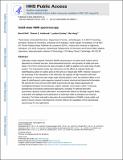Files in this item
Solid-state NMR spectroscopy
Item metadata
| dc.contributor.author | Reif, Bernd | |
| dc.contributor.author | Ashbrook, Sharon E | |
| dc.contributor.author | Emsley, Lyndon | |
| dc.contributor.author | Hong, Mei | |
| dc.date.accessioned | 2021-09-16T09:30:24Z | |
| dc.date.available | 2021-09-16T09:30:24Z | |
| dc.date.issued | 2021-01-14 | |
| dc.identifier.citation | Reif , B , Ashbrook , S E , Emsley , L & Hong , M 2021 , ' Solid-state NMR spectroscopy ' , Nature Reviews Methods Primers , vol. 1 , 2 . https://doi.org/10.1038/s43586-020-00002-1 | en |
| dc.identifier.issn | 2662-8449 | |
| dc.identifier.other | PURE: 275761567 | |
| dc.identifier.other | PURE UUID: b97854f8-72eb-4653-a8db-c3f3559c31b7 | |
| dc.identifier.other | RIS: urn:2333D12F39A1ABF81D96ADD5E739E01B | |
| dc.identifier.other | PubMedCentral: PMC8341432 | |
| dc.identifier.other | PubMed: 34368784 | |
| dc.identifier.other | Scopus: 85123202808 | |
| dc.identifier.other | WOS: 000888212900008 | |
| dc.identifier.uri | https://hdl.handle.net/10023/23971 | |
| dc.description | Funding: M.H. acknowledges support by National Institutes of Health (NIH) grant GM066976. | en |
| dc.description.abstract | Solid-state nuclear magnetic resonance (NMR) spectroscopy is an atomic-level method used to determine the chemical structure, three-dimensional structure, and dynamics of solids and semi-solids. This Primer summarizes the basic principles of NMR as applied to the wide range of solid systems. The fundamental nuclear spin interactions and the effects of magnetic fields and radiofrequency pulses on nuclear spins are the same as in liquid-state NMR. However, because of the anisotropy of the interactions in the solid state, the majority of high-resolution solid-state NMR spectra is measured under magic-angle spinning (MAS), which has profound effects on the types of radiofrequency pulse sequences required to extract structural and dynamical information. We describe the most common MAS NMR experiments and data analysis approaches for investigating biological macromolecules, organic materials, and inorganic solids. Continuing development of sensitivity-enhancement approaches, including 1H-detected fast MAS experiments, dynamic nuclear polarization, and experiments tailored to ultrahigh magnetic fields, is described. We highlight recent applications of solid-state NMR to biological and materials chemistry. The Primer ends with a discussion of current limitations of NMR to study solids, and points to future avenues of development to further enhance the capabilities of this sophisticated spectroscopy for new applications. | |
| dc.format.extent | 23 | |
| dc.language.iso | eng | |
| dc.relation.ispartof | Nature Reviews Methods Primers | en |
| dc.rights | Copyright © Springer Nature Limited 2021. This work has been made available online in accordance with publisher policies or with permission. Permission for further reuse of this content should be sought from the publisher or the rights holder. This is the author created accepted manuscript following peer review and may differ slightly from the final published version. The final published version of this work is available at https://doi.org/10.1038/s43586-020-00002-1 | en |
| dc.subject | QD Chemistry | en |
| dc.subject | MCC | en |
| dc.subject.lcc | QD | en |
| dc.title | Solid-state NMR spectroscopy | en |
| dc.type | Journal item | en |
| dc.description.version | Postprint | en |
| dc.contributor.institution | University of St Andrews. School of Chemistry | en |
| dc.contributor.institution | University of St Andrews. EaSTCHEM | en |
| dc.identifier.doi | https://doi.org/10.1038/s43586-020-00002-1 | |
| dc.description.status | Peer reviewed | en |
| dc.date.embargoedUntil | 2021-07-14 |
This item appears in the following Collection(s)
Items in the St Andrews Research Repository are protected by copyright, with all rights reserved, unless otherwise indicated.

